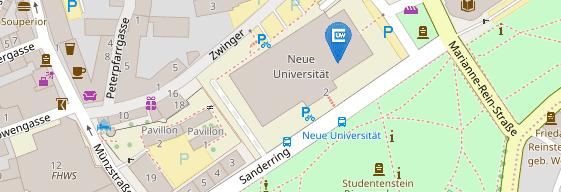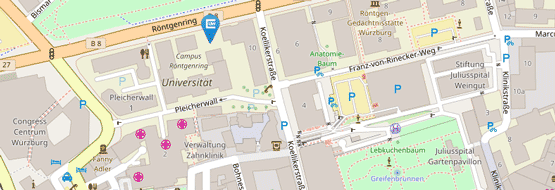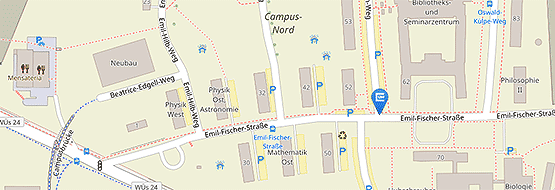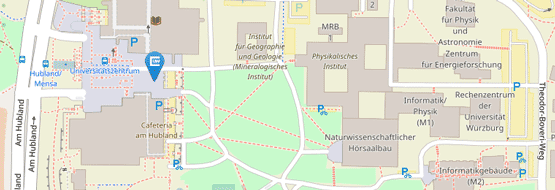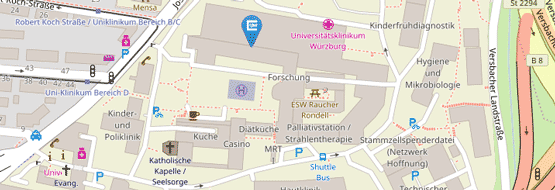Projects
In order to give you an insight into the current research of the Media and Business Communication department, we present below some selected research projects that we have successfully realised in recent years:
Prosocial advertising research - trends, focal points and perspectives in the last 20 years (2023-2025)

Research on the prosocial effects of media communication deals with the effects of media use on altruistic attitudes, behavioural intentions and behaviour of media users towards fellow human beings and the environment. The focus is on caring for disadvantaged social groups (out-groups) as well as dealing with sensitive areas of life that determine and often burden people's social coexistence (e.g. poverty, climate/environment, health/pandemics). The contribution of advertising research to this is questionable. A comprehensive systematic overview of the fields of pro-social advertising research and their development, focal points, perspectives and findings does not yet exist. Such an overview could reveal which fields are already being cultivated and which fields have not been cultivated to date, but which are suitable for advertising research in order to make a greater socially relevant contribution. To this end, we systematically analyse over 300 advertising studies from the last 20 years that have been published in the four leading international advertising journals.
AI influencers in environmental communication: influence of anthropomorphism and topic fit (2024-2025)

AI influencers are increasingly playing a role in the social media landscape, and their growing presence raises new questions about their effectiveness in strategic communication - particularly in environmental communication. This study examines the extent to which the degree of anthropomorphism of AI influencers influences perceptions of their credibility and intention to demonstrate pro-environmental behaviour. It also analyses the extent to which the perceived fit between the influencer and the environmental topic influences reception. To test these factors, an online experiment will be conducted to contribute to a better understanding of the potential and limitations of AI influencers in environmental communication.
Effects of music as an integral part of media content: A scoping review (2024)

Music is an integral part of a variety of media content - from the background music in a film to the soundtrack of a video game. Research into the effects of such integration of music does not yet reflect the prevalence of such music use and is scattered across different disciplines. Therefore, a scoping review was conducted with the aim of determining which disciplines deal with the effects of music as an integral part of media content, in what way and to what extent this takes place and which target variables are investigated there. Subsequently, various implications for future research and a more in-depth exploration of the field from a communication science perspective were derived from the desiderata identified.
Development of a short version of the PSI Process Scales (2022-2024)

Research into parasocial phenomena is flourishing. The PSI Process Scales (Schramm & Hartmann, 2008) offer a comprehensive instrument for assessing parasocial processes and have quickly become a widely used measurement tool in this field. However, the extensive length of the scale (112 items) poses a challenge for consistent and complete application, which usually leads to ad hoc modifications. To counteract these limitations, in this project we are developing - together with Tilo Hartmann and Philipp Masur from the VU Amsterdam - a shortened version of the PSI-Process Scales, the so-called Parasocial Processing Short Scale (PP-SS). The short scale is being systematically developed from the long version and validated in two pre-registered empirical studies, including an experiment and a larger survey study involving different media characters and diverse samples. The aim of the PP-SS is to provide PSI researchers with a concise and easy-to-use instrument that reliably and validly captures parasocial processes.
Usage motives of listeners of German-language popular music (2022)

In musicological literature, there are a number of beliefs about listeners of German-language popular music. Above all, pop music listeners are primarily interested in escaping from everyday life into an ideal world by consuming their favourite music. There is no empirical evidence to support this theory, nor that pop music listeners are less interested in intellectual pursuits per se or have a below-average musical education. Nevertheless, such descriptions circulate in the research literature. This is also due to the fact that many researchers have reservations about the supposedly trivial: Too simple, too trivial - and therefore not worth investigating? In an extensive survey study based on the so-called uses-and-gratifications approach, the MWK department is investigating the motives for using various German-language musical subgenres. In order to get to the bottom of common prejudices, personality traits are also being surveyed.
Persuasive influence of emotionally appropriate background music in audiovisual environmental communication on Instagram (2022)

Influencers on Instagram are increasingly promoting a sustainable and ecologically conscious lifestyle. Corresponding messages are often disseminated to followers in the form of short videos known as reels. Communication strategies such as message framing are used here: changes in attitude and behaviour are to be achieved by either emphasising what can be achieved through a certain behaviour or what can be lost by refraining from this behaviour. In addition to visual design options, the integration of background music from a music library provided by Instagram is an essential component of such reels. Previous research on audiovisual advertising has already identified the influence of suitable music in promoting the advertising effect. The research project investigates the extent to which different message framing leads to emotional reactions, whether these influence environmental behavioural intentions via various psychological mechanisms (self-efficacy, perceived seriousness) and whether emotionally appropriate background music influences this persuasive effect.
Status and importance of music research at German radio stations (2021-2022)

Music makes up the majority of radio programmes. For many listeners, it is the main reason for switching on the radio in the first place, but an increasing number of listeners are no longer switching on the radio at all and are using music streaming services instead. Radio broadcasters must therefore make greater efforts to distinguish themselves in the music market and to retain listener groups. The first two waves of this trend study 20 years ago and ten years ago showed that radio broadcasters are relying less and less on the gut feeling of music editors and more and more on figures from music research when it comes to optimising music for their target group. The current, third wave of this trend study examines whether this trend has intensified or weakened over the last ten years and what significance the new additional online feedback options for listeners now have for programme design.
Trends in recent research on parasocial interactions and relationships. An inventory (2021-2022)

60 years after the original essay by Horton and Wohl (1956), there are already over 250 studies on parasocial interactions (PSI) and relationships (PSB) in 2015, according to an initial survey by Liebers and Schramm (2017). Parasocial phenomena are now among the most popular and best-researched subject areas within reception and impact research, which are increasingly being addressed by media and communication science sub-disciplines outside of entertainment research, such as health communication, political communication and, above all, advertising communication, as well as noticeably by disciplines outside of media and communication science, such as marketing, tourism or human-computer interaction research. In particular, research into the parasocial phenomena of the use and impact of social media has received a noticeable boost in recent years. Between 2016 and 2020, a total of 281 studies were published - more than in the previous 60 years. What trends can be recognised in these studies? Where is PSI and PSB research heading thematically and methodologically? Which topics and issues are sometimes still neglected? In order to obtain answers to these research questions, we have undertaken a detailed and as complete as possible survey of this recent research on parasocial phenomena.
"That sounds shameful!": Stranger shame in music performances (2020)
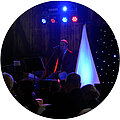
One off-key note, one slippery lyric - and suddenly you feel very uncomfortable as a spectator. Even if we only attend a questionable (musical) performance, we may feel ashamed of the behaviour of others. This vicarious feeling is colloquially referred to as "shaming others" . In general, this emotion can be seen as a reaction to the violation of norms or generally accepted social standards by another person.
Music performances in casting shows such as "Deutschland sucht den Superstar" can cause intense feelings of foreign shame in us. But is it more the musical aspects (such as the intonation) that trigger this feeling or the content (such as sexualised lyrics that are perceived as inappropriate)? Does the gender of the person making a fool of themselves influence the extent to which we find something embarrassing? In this project, we are investigating which characteristics of a performance influence the feeling of external shame.
Nostalgic effects when listening to popular series theme music from childhood (2019)

Children's television series are among the favourite media offerings of 6 to 13-year-olds. This could explain why adults also have fond memories of their childhood series and long for the nostalgic feelings of the "good old days". Nostalgia has already been researched in the context of children's television series and the connection between nostalgia and well-being has been proven. Studies on the nostalgic effect of individual components, especially the auditory components, of these media offerings are still pending. The emotional and associative potential of well-known pop music from the past is undisputed in research. But can even the much shorter fragments of the popular theme music of series known from childhood tap into this potential and contribute to a nostalgia-based mood enhancement in isolation, i.e. without the visual level of these series?
Home in the media (2018)

For many people, home is their home, but the term stands for more: for the place where you grew up, for people you feel you belong to, for landscapes, language or dialects, traditions and customs as well as for feelings of security, safety, contentment and cosiness.
Due to growing global and individual private insecurities, Germans have had a strong need for these feelings for years - and politics and the media are increasingly catering to this need. But what characterises home-related media offerings, why are so many people using them and what emotional and social effects do they have? The Department of Media and Business Communication is systematically investigating these questions in a multi-year project (funded by the DFG, among others).
Putin's games reloaded? (2017)
One more year until the World Cup, one more year until the whole of Germany is on fire for football. Then all eyes will be on Russia and viewers may get to know completely new sides of Russia as part of the World Cup coverage. This is an opportunity for a preliminary study to investigate the topics with which Russia will be associated by various news media during the Confed Cup. Will viewers be given their first insights into Russian culture or will political, more conflict-ridden topics continue to predominate? And to what extent do political and sporting topics intermingle? The results of this study will form the basis for a comprehensive analysis in the World Cup year.
Effect of Musical Fit in TV commercials (2016)
Musical fit - the perceived fit between music and commercials - has not yet been uniformly defined in research and has accordingly been implemented very differently in analyses and, above all, experiments. The instrument for determining musical fit in TV adverts, which was therefore developed in the previous year's project (Use of music in German TV advertising) and tested in practice using content analysis, must now pass its test in an experiment in 2016: Do recipients perceive the different degrees of musical fit in the adverts created with the help of the tool? Does a particularly high musical fit lead, as expected, to a better evaluation of the product and advert, a stronger brand recall and an increased intention to buy the product? These questions will be investigated in more detail in a broad-based pretest (14 versions of a commercial with different soundtracks for six musical fit types in four musical fit levels) in the summer semester and a laboratory experiment (six final stimulus versions) in the winter semester.
Use of music in German television advertising (2015)

The Media and Business Communication department takes a closer look at the commercials of the major German television stations RTL and Sat.1. The content is analysed to determine whether, how and which music is used in German television commercials. In addition, the characteristics of the adverts are coded, for example the form (use of testimonials, narrative staging or a lure?) and the demographics of the actors. To gain a suitable insight, the commercials are coded during prime time (8.00 pm to 11.00 pm). A total of around 1,500 commercials will be analysed
The 2014 Winter Olympics: National pride and nation evaluation (2013/14)
Together with a team of researchers from the University of Alabama (USA), we are conducting a survey study on the 2014 Winter Olympics in Sochi (Russia). The data will be collected simultaneously in the USA and Germany and should provide insights into the extent to which Germans and Americans differ in terms of national pride due to the different broadcasting of the Winter Olympics in the two countries. We are also interested in how the coverage as well as the victories and defeats of their own athletes influence the perception of competing nations (Russia, Austria, Norway, France). In a total of four survey waves before, during and after the Olympic Games, the aim is to record how sports coverage changes pride in one's own nation and the perception of other nations.
Music research at radio stations: How listeners perceive the station (2013/14)
In cooperation with a major radio station, the Media and Business Communication department is researching how radio listeners perceive a station. As a follow-up project to the study from 2012/13, a new focus is now to be placed on programme design. Beyond the usual radio tests, the research team wants to find out how the entire radio programme is perceived by listeners. A special focus will be placed on the station's spoken contributions such as moderation, service and news. The project will run until summer 2014.
Perception, use and impact of music casting shows (2013/14)
Music casting shows have been among the most successful German television formats since the 1990s. The most well-known in Germany include Popstars, Deutschland sucht den Superstar and The Voice of Germany. However, the formats differ significantly in their conception and marketing. The Media and Business Communication department has set itself the task of researching the perception, impact and utilisation of the various casting shows. A comprehensive study was conducted at the end of 2013 for the current third season of The Voice .
Music research at radio stations: How listeners experience the programme (2012/13)
The Department of Media and Business Communication is working together with a major radio station to find out more about the preferences of radio listeners. The project goes beyond conventional radio tests with listeners: the researchers are particularly interested in how recipients experience entire music programmes. The aim is to derive from this, among other things, how a programme can be optimally designed in terms of complexity, familiarity and other parameters. The third-party funded project was completed in summer 2013.
Acceptance and impact of product placement on television (2012/13)
Most viewers find commercial breaks during films or series annoying. In contrast, the placement of products and brands in films is more readily accepted because it is less conspicuous and does not interfere with the viewing experience. Product placements are therefore an interesting option for the advertising industry to promote products and brands, and we are interested in the concept of parasocial interaction (PSI) when analysing the effect of product placements. The focus here is on the extent to which recipients' cognitive, affective and conative engagement with media characters using product placements influences brand evaluation. For example, we ask ourselves how brand evaluation changes when recipients empathise with media characters or think intensively about their actions.
Utilisation, perception and impact of the European Men's Football Championship (2012)
This year, our work area is once again on the ball at the same time as the European Football Championships: with our survey on the European Championships, we are once again investigating a wide range of questions on the media experience of the European Football Championships. In addition to the motives for use, this time we are also interested in questions about the perception of other football teams and the host countries. Will the image we have of the Poles and Ukrainians change over the course of the tournament? Is the style of play of the European champions, the Spanish, actually rated better than that of the Germans? And how does the expectation of your favourite team's performance relate to your personal mood after a match? We want to answer these and many other questions. Our co-operation partner is once again the German Football Association (DFB), which links to our study on its homepage and on Facebook.
Utilisation, impact and marketing potential of the Women's World Cup (2011)
Just in time for the start of the Women's Football World Cup, the Media and Business Communication department is once again launching a major online survey on television viewing of the World Cup matches. The study follows on from previous studies on the 2006/2010 men's football World Cups, aims to record the current use of the World Cup matches and attempt to estimate the future viewing and marketing potential of women's football. Co-operation partners are the German Football Association (DFB), ZDF and Mainpost, which are publicising the survey on their homepages.
Music research and selection at German radio stations and their significance for strategic station orientation (2011)
Music makes up the majority of radio programmes. For many listeners, it is the main reason for switching on the radio and choosing a particular station. Radio stations therefore try to distinguish themselves on the radio market by playing selected music genres and to retain listener groups. Ten years ago, a previous study showed that stations are relying less and less on the gut feeling of music editors and more and more on figures from music research to optimise music for their target group. The current study aims to examine whether this trend has intensified or weakened over the last ten years. The aim is to gain as accurate a current picture as possible of music research and selection by radio stations and to establish what contribution it makes to the strategic market orientation of the stations. As was the case ten years ago, the study is designed as a complete survey. All radio stations in Germany will therefore be contacted. The data is collected via an online survey.


